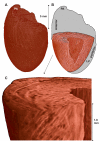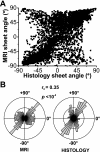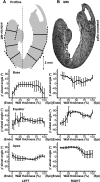Visualization and quantification of whole rat heart laminar structure using high-spatial resolution contrast-enhanced MRI
- PMID: 22021329
- PMCID: PMC3334235
- DOI: 10.1152/ajpheart.00824.2011
Visualization and quantification of whole rat heart laminar structure using high-spatial resolution contrast-enhanced MRI
Abstract
It has been shown by histology that cardiac myocytes are organized into laminae and this structure is important in function, both influencing the spread of electrical activation and enabling myocardial thickening in systole by laminar sliding. We have carried out high-spatial resolution three-dimensional MRI of the ventricular myolaminae of the entire volume of the isolated rat heart after contrast perfusion [dimeglumine gadopentate (Gd-DTPA)]. Four ex vivo rat hearts were perfused with Gd-DTPA and fixative and high-spatial resolution MRI was performed on a 9.4T MRI system. After MRI, cryosectioning followed by histology was performed. Images from MRI and histology were aligned, described, and quantitatively compared. In the three-dimensional MR images we directly show the presence of laminae and demonstrate that these are highly branching and are absent from much of the subepicardium. We visualized these MRI volumes to demonstrate laminar architecture and quantitatively demonstrated that the structural features observed are similar to those imaged in histology. We showed qualitatively and quantitatively that laminar architecture is similar in the four hearts. MRI can be used to image the laminar architecture of ex vivo hearts in three dimensions, and the images produced are qualitatively and quantitatively comparable with histology. We have demonstrated in the rat that: 1) laminar architecture is consistent between hearts; 2) myolaminae are absent from much of the subepicardium; and 3) although localized orthotropy is present throughout the myocardium, tracked myolaminae are branching structures and do not have a discrete identity.
Figures










References
-
- Abramoff MD, Magelhaes PJ, Ram SJ. Image processing with ImageJ. Biophotonics International 11: 36–42, 2004
-
- Anderson RH, Smerup M, Sanchez-Quintana D, Loukas M, Lunkenheimer PP. The three-dimensional arrangement of the myocytes in the ventricular walls. Clin Anat 22: 64–76, 2009 - PubMed
-
- Arts T, Costa KD, Covell JW, McCulloch AD. Relating myocardial laminar architecture to shear strain and muscle fiber orientation. Am J Physiol Heart Circ Physiol 280: H2222–H2229, 2001 - PubMed
-
- Berens P. CircStat: a MATLAB Toolbox for Circular Statistics. Journal of Statistical Software 31: 1–21, 2009
Publication types
MeSH terms
Substances
Grants and funding
LinkOut - more resources
Full Text Sources
Medical

